Abstract
Two strains of Escherichia coli and one strain each of Salmonella typhimurium and Pseudomonas aeruginosa were killed by the bactericidal activity of the lactoperoxidase-thiocyanate-hydrogen peroxide system in milk and in a synthetic medium. H2O2 was supplied exogenously by glucose oxidase, and glucose was produced at a level which was itself noninhibitory. Two phases were distinguished: the first phase was dependent on the oxidation of SCN(-) by lactoperoxidase and H2O2, which was reversed by reducing agent, and the second phase was dependent on the presence of accumulated H2O2, which was reversed by catalase. The latter enzyme could also reverse the first phase, but only when present in excessive and unphysiological levels. The bactericidal activity was greatest at pH 5 and below, and it depended on the SCN(-)concentration and on the number of organisms. Since raw or heated milk neutralizes the acid barrier against infection in the stomach, the bactericidal system discussed may contribute to the prevention of enteric infections in neonates.
Full text
PDF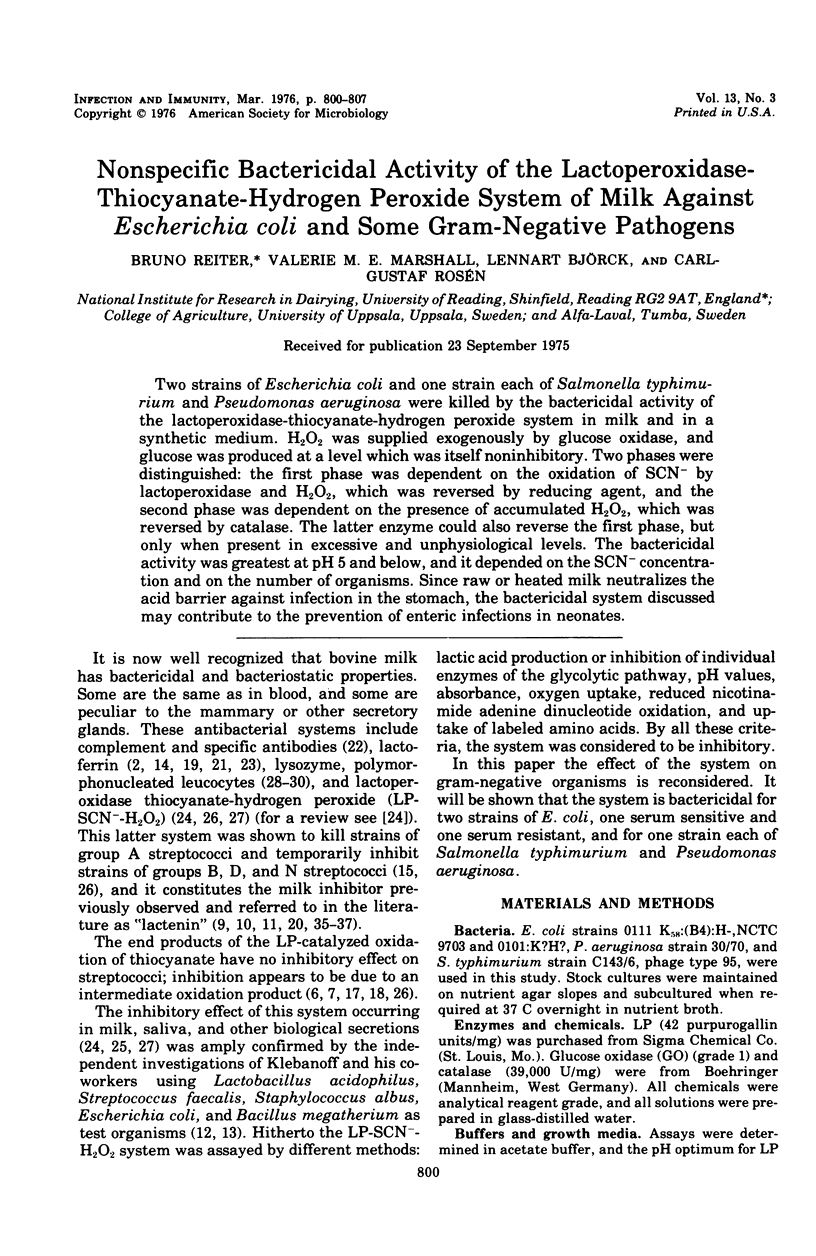

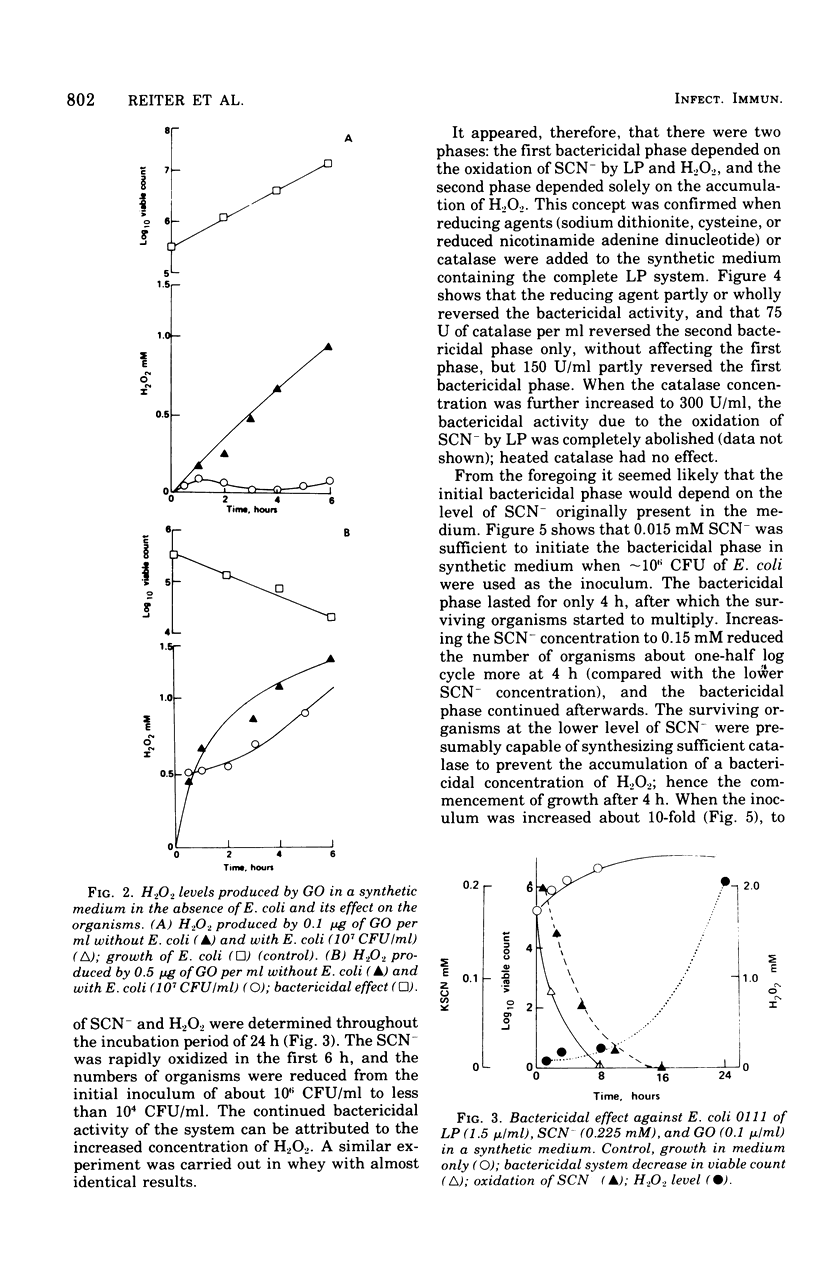

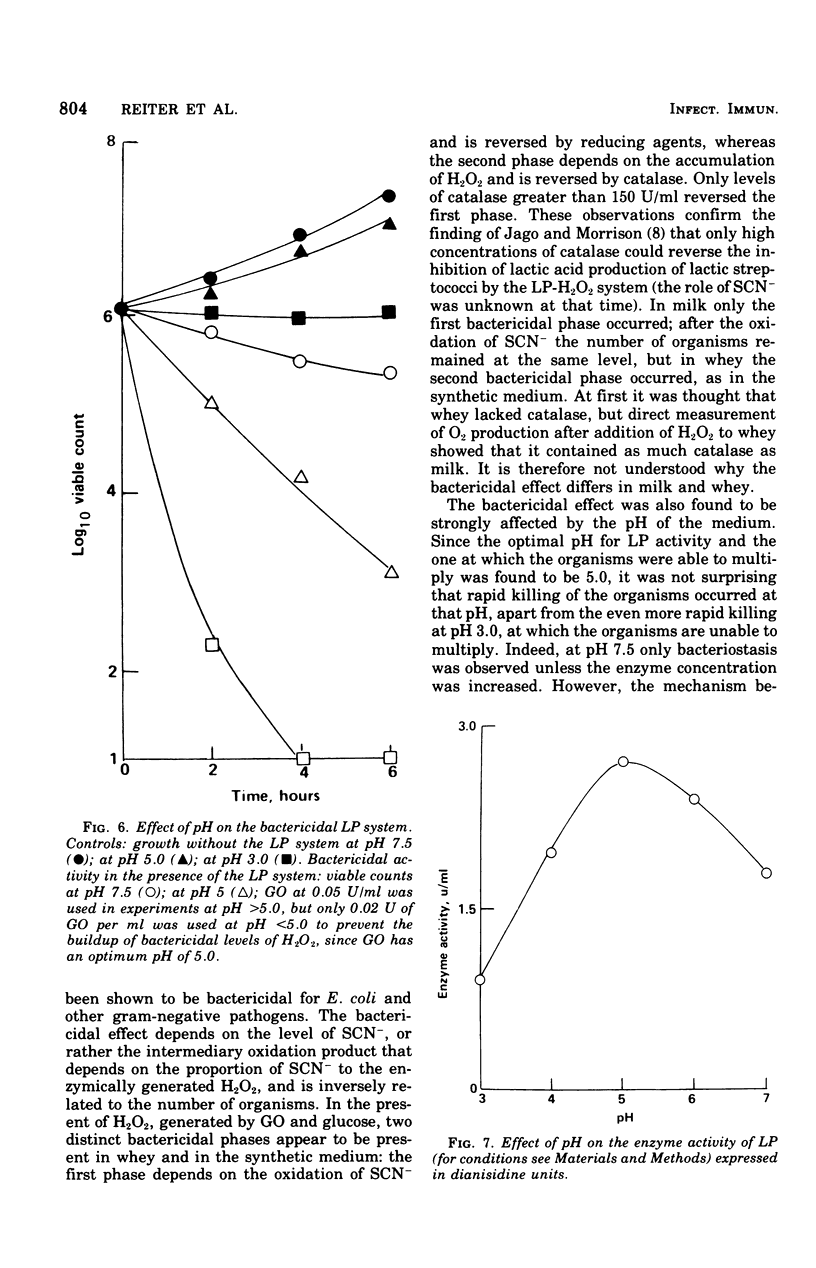

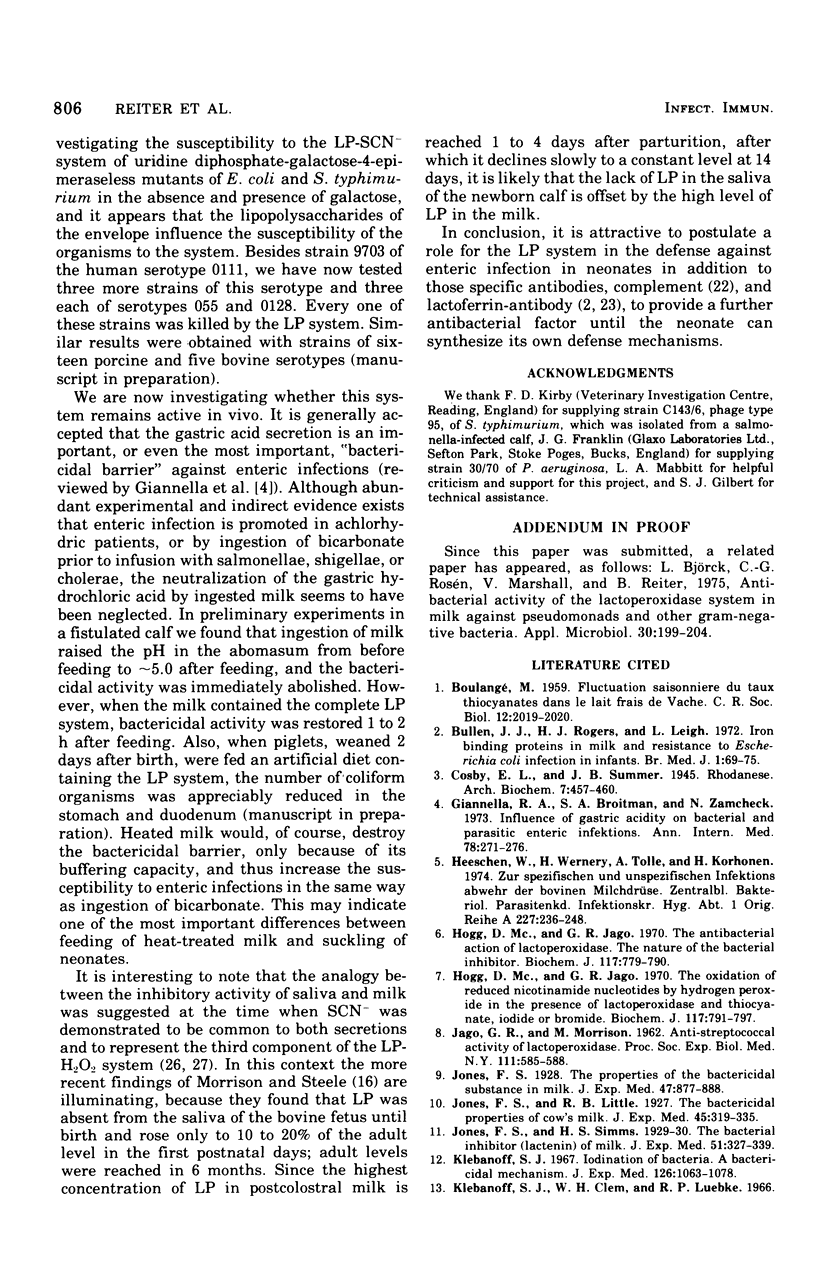
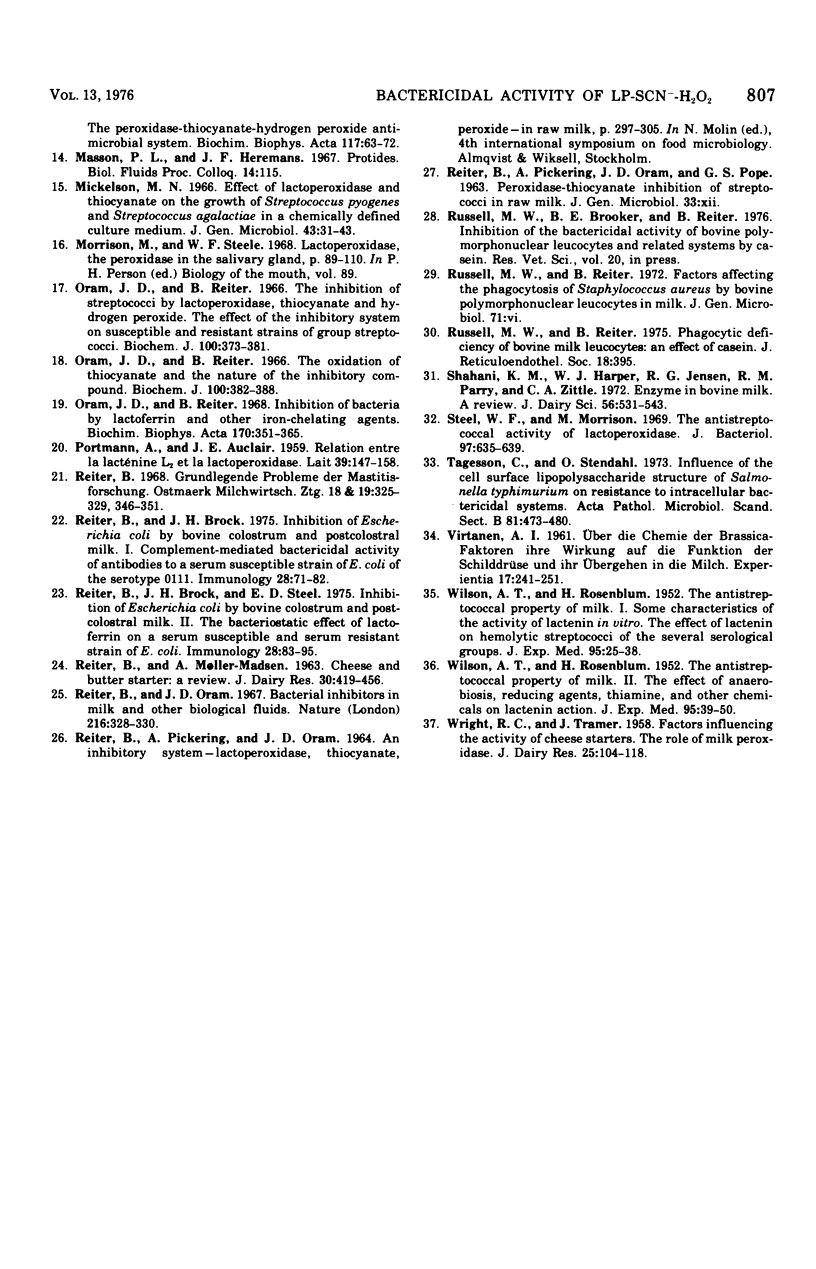
Selected References
These references are in PubMed. This may not be the complete list of references from this article.
- Björck L., Rosén C., Marshall V., Reiter B. Antibacterial activity of the lactoperoxidase system in milk against pseudomonads and other gram-negative bacteria. Appl Microbiol. 1975 Aug;30(2):199–204. doi: 10.1128/am.30.2.199-204.1975. [DOI] [PMC free article] [PubMed] [Google Scholar]
- Bullen J. J., Rogers H. J., Leigh L. Iron-binding proteins in milk and resistance to Escherichia coli infection in infants. Br Med J. 1972 Jan 8;1(5792):69–75. doi: 10.1136/bmj.1.5792.69. [DOI] [PMC free article] [PubMed] [Google Scholar]
- Giannella R. A., Broitman S. A., Zamcheck N. Influence of gastric acidity on bacterial and parasitic enteric infections. A perspective. Ann Intern Med. 1973 Feb;78(2):271–276. doi: 10.7326/0003-4819-78-2-271. [DOI] [PubMed] [Google Scholar]
- Heeschen W., Wernery H., Tolle A., Korhonen H. Zur spezifischen und unspezifischen Infektionsabwehr der bovinen Milchdrüse. Zentralbl Bakteriol Orig A. 1974;227(1-4):236–248. [PubMed] [Google Scholar]
- Hogg D. M., Jago G. R. The antibacterial action of lactoperoxidase. The nature of the bacterial inhibitor. Biochem J. 1970 May;117(4):779–790. doi: 10.1042/bj1170779. [DOI] [PMC free article] [PubMed] [Google Scholar]
- Hogg D. M., Jago G. R. The oxidation of reduced nicotinamide nucleotides by hydrogen peroside in the presence of lactoperoxidase and thiocyanate, iodide or bromide. Biochem J. 1970 May;117(4):791–797. doi: 10.1042/bj1170791. [DOI] [PMC free article] [PubMed] [Google Scholar]
- JAGO G. R., MORRISON M. Anti-streptococcal activity of lactoperoxidase III. Proc Soc Exp Biol Med. 1962 Dec;111:585–588. doi: 10.3181/00379727-111-27862. [DOI] [PubMed] [Google Scholar]
- Klebanoff S. J., Clem W. H., Luebke R. G. The peroxidase-thiocyanate-hydrogen peroxide antimicrobial system. Biochim Biophys Acta. 1966 Mar 28;117(1):63–72. doi: 10.1016/0304-4165(66)90152-8. [DOI] [PubMed] [Google Scholar]
- Klebanoff S. J. Iodination of bacteria: a bactericidal mechanism. J Exp Med. 1967 Dec 1;126(6):1063–1078. doi: 10.1084/jem.126.6.1063. [DOI] [PMC free article] [PubMed] [Google Scholar]
- Mickelson M. N. Effect of lactoperoxidase and thiocyanate on the growth of Streptococcus pyogenes and Streptococcus agalactiae in a chemically defined culture medium. J Gen Microbiol. 1966 Apr;43(1):31–43. doi: 10.1099/00221287-43-1-31. [DOI] [PubMed] [Google Scholar]
- Oram J. D., Reiter B. Inhibition of bacteria by lactoferrin and other iron-chelating agents. Biochim Biophys Acta. 1968 Dec 23;170(2):351–365. doi: 10.1016/0304-4165(68)90015-9. [DOI] [PubMed] [Google Scholar]
- Oram J. D., Reiter B. The inhibition of streptococci by lactoperoxidase, thiocyanate and hydrogen peroxide. The effect of the inhibitory system on susceptible and resistant strains of group N streptococci. Biochem J. 1966 Aug;100(2):373–381. doi: 10.1042/bj1000373. [DOI] [PMC free article] [PubMed] [Google Scholar]
- Oram J. D., Reiter B. The inhibition of streptococci by lactoperoxidase, thiocyanate and hydrogen peroxide. The oxidation of thiocyanate and the nature of the inhibitory compound. Biochem J. 1966 Aug;100(2):382–388. doi: 10.1042/bj1000382. [DOI] [PMC free article] [PubMed] [Google Scholar]
- Reite B., Oram J. D. Bacterial inhibitors in milk and other biological fluids. Nature. 1967 Oct 28;216(5113):328–330. doi: 10.1038/216328a0. [DOI] [PubMed] [Google Scholar]
- Reiter B., Brock J. H. Inhibition of Escherichia coli by bovine colostrum and post-colostral milk. I. Complement-mediated bactericidal activity of antibodies to a serum susceptible strain of E. coli of the serotype O 111. Immunology. 1975 Jan;28(1):71–82. [PMC free article] [PubMed] [Google Scholar]
- Reiter B., Brock J. H., Steel E. D. Inhibition of Escherichia coli by bovine colostrum and post-colostral milk. II. The bacteriostatic effect of lactoferrin on a serum susceptible and serum resistant strain of E. coli. Immunology. 1975 Jan;28(1):83–95. [PMC free article] [PubMed] [Google Scholar]
- Shahani K. M., Herper W. J., Jensen R. G., Parry R. M., Jr, Zittle C. A. Enzymes in bovine milk: a review. J Dairy Sci. 1973 May;56(5):531–543. doi: 10.3168/jds.s0022-0302(73)85216-6. [DOI] [PubMed] [Google Scholar]
- Steele W. F., Morrison M. Antistreptococcal activity of lactoperoxidase. J Bacteriol. 1969 Feb;97(2):635–639. doi: 10.1128/jb.97.2.635-639.1969. [DOI] [PMC free article] [PubMed] [Google Scholar]
- Tagesson C., Stendahl O. Influence of the cell surface lipopolysaccharide structure of Salmonella typhimurium on resistance to intracellular bactericidal systems. Acta Pathol Microbiol Scand B Microbiol Immunol. 1973 Aug;81(4):473–480. doi: 10.1111/j.1699-0463.1973.tb02232.x. [DOI] [PubMed] [Google Scholar]
- VIRTANEN A. I. [On the chemistry of Brassica factors, their effect on thyroid function and their changes in the spleen]. Experientia. 1961 Jun 15;17:241–251. doi: 10.1007/BF02161421. [DOI] [PubMed] [Google Scholar]
- WILSON A. T., ROSENBLUM H. The antistreptococcal property of milk. I. Some characteristics of the activity of lactenin in vitro; the effect of lactenin on hemolytic streptococci of the several serological groups. J Exp Med. 1952 Jan;95(1):25–38. doi: 10.1084/jem.95.1.25. [DOI] [PMC free article] [PubMed] [Google Scholar]
- WILSON A. T., ROSENBLUM H. The antistreptococcal property of milk. II. The effects of anaerobiosis, reducing agents, thiamine, and other chemicals on lactenin action. J Exp Med. 1952 Jan;95(1):39–50. doi: 10.1084/jem.95.1.39. [DOI] [PMC free article] [PubMed] [Google Scholar]


